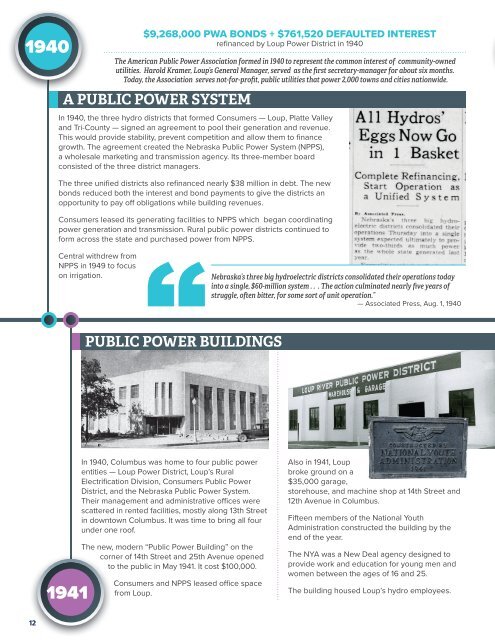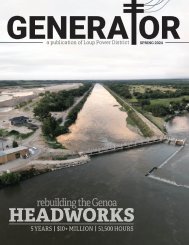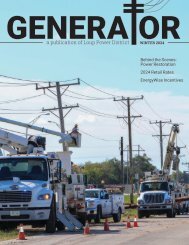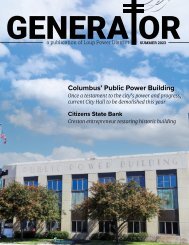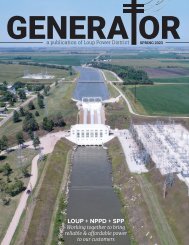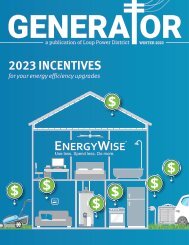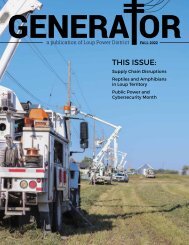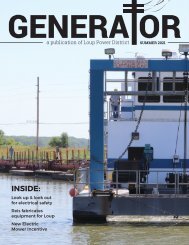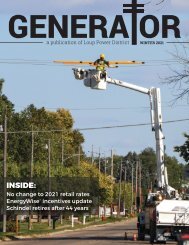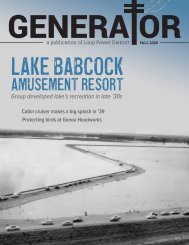Generator—Fall 2023
Loup is 90 years old! Learn more about our interesting history in this edition of the Loup Generator. Other topics include Public Power Month, cybersecurity tips, and a retiree feature on Jim Jakub.
Loup is 90 years old! Learn more about our interesting history in this edition of the Loup Generator. Other topics include Public Power Month, cybersecurity tips, and a retiree feature on Jim Jakub.
You also want an ePaper? Increase the reach of your titles
YUMPU automatically turns print PDFs into web optimized ePapers that Google loves.
1940<br />
$9,268,000 PWA BONDS + $761,520 DEFAULTED INTEREST<br />
refinanced by Loup Power District in 1940<br />
The American Public Power Association formed in 1940 to represent the common interest of community-owned<br />
utilities. Harold Kramer, Loup’s General Manager, served as the first secretary-manager for about six months.<br />
Today, the Association serves not-for-profit, public utilities that power 2,000 towns and cities nationwide.<br />
A PUBLIC POWER SYSTEM<br />
In 1940, the three hydro districts that formed Consumers — Loup, Platte Valley<br />
and Tri-County — signed an agreement to pool their generation and revenue.<br />
This would provide stability, prevent competition and allow them to finance<br />
growth. The agreement created the Nebraska Public Power System (NPPS),<br />
a wholesale marketing and transmission agency. Its three-member board<br />
consisted of the three district managers.<br />
The three unified districts also refinanced nearly $38 million in debt. The new<br />
bonds reduced both the interest and bond payments to give the districts an<br />
opportunity to pay off obligations while building revenues.<br />
Consumers leased its generating facilities to NPPS which began coordinating<br />
power generation and transmission. Rural public power districts continued to<br />
form across the state and purchased power from NPPS.<br />
Central withdrew from<br />
NPPS in 1949 to focus<br />
on irrigation.<br />
Nebraska’s three big hydroelectric districts consolidated their operations today<br />
into a single, $60-million system . . . The action culminated nearly five years of<br />
struggle, often bitter, for some sort of unit operation.”<br />
— Associated Press, Aug. 1, 1940<br />
PUBLIC POWER BUILDINGS<br />
1941<br />
In 1940, Columbus was home to four public power<br />
entities — Loup Power District, Loup’s Rural<br />
Electrification Division, Consumers Public Power<br />
District, and the Nebraska Public Power System.<br />
Their management and administrative offices were<br />
scattered in rented facilities, mostly along 13th Street<br />
in downtown Columbus. It was time to bring all four<br />
under one roof.<br />
The new, modern “Public Power Building” on the<br />
corner of 14th Street and 25th Avenue opened<br />
to the public in May 1941. It cost $100,000.<br />
Consumers and NPPS leased office space<br />
from Loup.<br />
Also in 1941, Loup<br />
broke ground on a<br />
$35,000 garage,<br />
storehouse, and machine shop at 14th Street and<br />
12th Avenue in Columbus.<br />
Fifteen members of the National Youth<br />
Administration constructed the building by the<br />
end of the year.<br />
The NYA was a New Deal agency designed to<br />
provide work and education for young men and<br />
women between the ages of 16 and 25.<br />
The building housed Loup’s hydro employees.<br />
12


